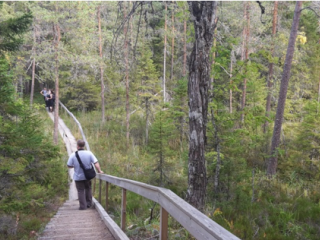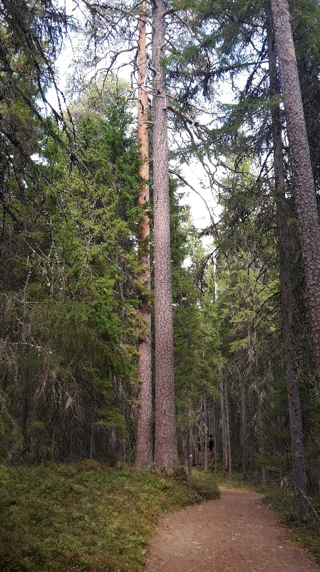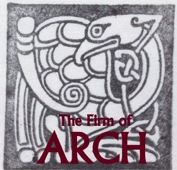Reflections on Finland
Doug Gilbert, Dundreggan Operations Manager, travelled to Finland to get acquainted with Finnish nature and environmental education practices. This programme was developed by Erasmus+ to further our understanding of forest education and research, appreciate how wildlife such as elk, beaver, capercaillie and their habitats are managed and to see examples of how recreation and food from forests can boost nature tourism.
Reflections on Finland
By Doug Gilbert
Along with colleagues from Woodland Trust Scotland, RSPB, Forest Enterprise, Highlife Highland and the Institute of Chartered Foresters, I recently took part in an Erasmus+ NET 4 visit to Tampere in southern Finland, hosted by the Tampere Institute of Applied Sciences (TAMK) and organised by Arch.
 Our first look at the Finnish forest habitat was at Seitseminen National Park. The forest consisted of Scot’s pine, Norway spruce, aspen and silver birch, with a scattering of smaller understorey trees like alder and willow. It had the feeling of a plantation (though a very nice one) back home in Scotland. Finland has never gone in for vast plantations of non-native trees – why would they when there is an abundance of native trees which can be used for timber and firewood. The ground was rich with a thick moss-lichen everywhere, abundant in herbs such as twinflower, May lily, lily of the valley, Labrador tea, hepatica (a delicate blue flower not found in Scotland) along with a range of familiar heathery shrubs. There was a fair scattering of natural regeneration of Scot’s pine, Norway spruce and broadleaves, including some rowan, although this was being browsed back.
Our first look at the Finnish forest habitat was at Seitseminen National Park. The forest consisted of Scot’s pine, Norway spruce, aspen and silver birch, with a scattering of smaller understorey trees like alder and willow. It had the feeling of a plantation (though a very nice one) back home in Scotland. Finland has never gone in for vast plantations of non-native trees – why would they when there is an abundance of native trees which can be used for timber and firewood. The ground was rich with a thick moss-lichen everywhere, abundant in herbs such as twinflower, May lily, lily of the valley, Labrador tea, hepatica (a delicate blue flower not found in Scotland) along with a range of familiar heathery shrubs. There was a fair scattering of natural regeneration of Scot’s pine, Norway spruce and broadleaves, including some rowan, although this was being browsed back.
Along with a stable population of elk, Finland has a rapidly expanding population of white-tailed deer. This non-native American deer – a little smaller than our red deer, but just as fond of young trees – will certainly cause problems in the future for the Finns. In 1934, five white-tailed deer were introduced to Finland, in the area around Tampere. Within the last decade, the white-tailed deer population in Finland has doubled to around 100,000, spreading to almost every corner of the southern part of the country. The number of traffic accidents involving white-tailed deer is in the thousands, and each year, the animals cause significant damage to farmers' crops and forest preservation efforts. For example, officials in the area of Ruissalo in Turku stepped up hunting of white-tailed deer after the animals became a threat to the area's protected oak forests.
 Land management is very uniform across much of southern Finland. Forestry is overwhelmingly abundant, compared to farmland and towns/cities. The majority of forests are Programme for the Endorsement of Forest Certification (PEFC) certified, very few are the more stringent Forest Stewardship Council (FSC) certification standard by which many Scottish woods abide. The average land ownership in Finland is less than 100 hectares, which means most woodland management is carried out at this scale – a refreshing change to some of the monocultural land management landscapes we have in Scotland.
Land management is very uniform across much of southern Finland. Forestry is overwhelmingly abundant, compared to farmland and towns/cities. The majority of forests are Programme for the Endorsement of Forest Certification (PEFC) certified, very few are the more stringent Forest Stewardship Council (FSC) certification standard by which many Scottish woods abide. The average land ownership in Finland is less than 100 hectares, which means most woodland management is carried out at this scale – a refreshing change to some of the monocultural land management landscapes we have in Scotland.
We visited a patch of old growth forest within the park. Surprisingly, we found it strikingly similar to new growth forest! There was low species diversity in the canopy (Scot’s pine, Norway spruce, aspen, silver birch, grey alder) and all the trees were telegraph pole straight with no large side branches and hardly any “characterful” trees, as we get in many Scottish woods (e.g. Granny pines). Our Finnish guide Miia suggested many of the trees are 200 years old while the oldest trees mentioned on the National Park website are 400 years old.
Later in the week we visited a commercial forest where small-scale clear felled areas had been planted up with Scot’s pine and silver birch. It’s unclear why there was a need to plant as there was so much scope for natural regeneration. With low deer pressure (for now) the Finns don’t have to worry about fencing – imagine that in Scotland! – planted trees were left unprotected from browsing with an expectation they will survive. At a different site we saw a small area of felled forest which had been deliberately burned to reduce the dominance of the mossy ground layer, and speed up nutrient cycling prior to planting. We were later told of several species of insect and fungi that depend on charred wood for their habitat and that patch burning like this was being encouraged – in fact, ecologists wanted to see far bigger fires allowed to develop! Controlled burning is claimed to have many benefits as a soil preparation method in Finnish forestry. It increases nutrients and reduces undergrowth for a while. The soil is warmer in the summer because the heat-insulating humus layer becomes thinner. In addition, controlled burning is known to reduce pest species, especially "annosum root rot" (Heterobasidion annosum), financially the most important forest pathogen in the Northern hemisphere. Controlled burning increases the volume of decaying and burnt wood, which is necessary for many endangered species.
But, sadly, Finland’s protection of old-growth forest has been as lamentable as our own. Ancient forest fragments exist within the wider forest covering most of Finland, but they are small and isolated, even though commercially managed native woodland is so abundant. This means that creatures and plants adapted to undisturbed woodlands are rare and threatened even here.
We spent time visiting other woodland and bog sites, and an urban “forest school” as well as having the opportunity to talk to Ecology and Forestry College staff from TAMK. Our take home message from Finland was that, even with 70% or more of the land surface covered in (more or less) native forest, Finland still has a lot to do to protect woodland habitats of high nature conservation importance. Scotland’s native woodland fragments are every bit as important as those in Finland and Trees for Life’s vision of larger, better connected native forests is equally relevant in both countries.




